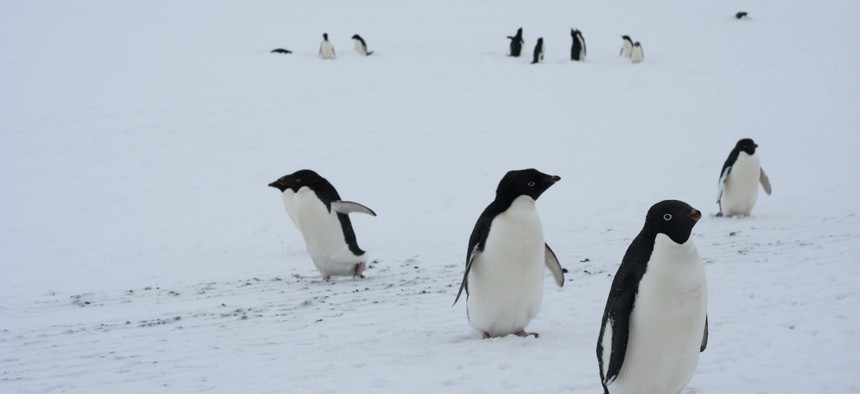
Possible research might have included studying Adele penguins. Flickr user eliduke
The Shutdown Has Halted These Scientific Research Projects
In addition to NIH clinical trials, Antarctica research, paleontology projects and disease tracking are on hold.
Countless federal projects have been stymied by the shutdown of the federal government. Entering the ninth day of the shutdown, much coverage has focused on the impact on federal agencies as well as the capital's monuments and Smithsonian museums. What's less known is that the Smithsonian is also an international research organization that employs thousands of scientists.
What follows is a rundown of some of the federal science programs that have been hobbled at the Smithsonian here and beyond.
1. Smithsonian's international research projects
Nick Pysenson of the Natural History Museum excavates ancient fossils to analyze the evolution of modern marine mammals. Peysenon has conducted fieldwork on every continent except Antarctica. His team, currently stationed in Chile, is doing 3D scans of whale, penguin, and seal fossils, but thanks to the shutdown he'll be stopping his research.
"The Smithsonian is closed, due to a federal government #shutdown. All Pyenson Lab social media, including coverage of the ongoing joint Chile expedition, will be suspended starting 12 pm EST (noon) today (1 Oct)," he wrote on Facebook. "Also, all federally funded Smithsonian employees are forbidden, under penalty of a $5,000.00 fine and up to 2 years in a federal prison, from logging into their SI email accounts. I will be out of contact until the federal government reopens."
Smithsonian has posted a partial list of its projects affected by the shutdown, including some that may have to be started over due to gaps in scientific data.
2. Antarctica research
Three Antarctica-based American research stations have been put on "caretaker" status and have ceased all research thanks to the shutdown, according to the United States Antarctic Program. That means all staff deemed "inessential" will be sent down and their research ended.
"Under caretaker status, the USAP will be staffed at a minimal level to ensure human safety and preserve government property, including the three primary research stations, ships, and associated research facilities," the Antarctic Program said in a statement. "All field and research activities not essential to human safety and preservation of property will be suspended."
USAP received its last round of cash on Sept. 30 and will run out of funds by Oct. 14.
3. Disease tracking
The Centers for Disease Control and Prevention has stalled programs for tracking outbreaks of influenza, salmonella, measles, and other deadly diseases, given that two thirds of its staff are on furlough.
"The vast majority of the CDC is actively in the process of shutting down," agency spokeswoman Barbara Reynolds told ABC News last week. "We've gotten really good at trying to find outbreaks, but our strong network is getting weaker.... This is spotty."
4. NIH clinical trials
Over at the National Institutes of Health, government researchers have been barred from their own labs and told they cannot travel anywhere during the shutdown. "They told us giving a talk after that was a federal crime," one NIH immunologist told Nature.
What's worse, with about 75 percent of NIH staff on furlough, new patients are unable to enroll in clinical trials at the NIH Clinical Center. That means as many as 200 people a week won't be able to obtain the care they need, including this cancer patient, interviewed here by Wonkblog's Sarah Kliff.
(Image via Flickr user eliduke)
NEXT STORY: 4 Elements That Promote Effective Coordination






